You are right if you feel that Singapore has been getting more crowded.
According to the Government’s annual Population in Brief report, Singapore’s population is currently around 5.9 million.
The report was released on 29 September.
The report, which provides data and critical updates on the country’s population trends, also details Singapore’s marriage rate, birth rate, non-resident population and ageing population.
If you feel too lazy to read the whole report, here is a summary.
Love in the Air: Marriage Rates a Record High
24,767 citizen marriages occurred in 2022.
This is an increase from 2021, which saw 23,433 marriages.
Of course, this increase can be attributed to our friend, COVID-19.

The COVID-19 restrictions caused many wedding plans to be disrupted.
For instance, in May 2021, wedding receptions were banned to prevent new COVID-19 clusters from forming in the community.
Now that restrictions have been mostly lifted, couples probably resumed their wedding plans, leading to increased marriage rates.
However, the annual average number of citizen marriages in the past five years, standing at 22,700, has remained lower than in the preceding five years.
Furthermore, people are getting married at a slightly later age.
The median age at first marriage for citizen grooms and brides was 30.5 and 28.8 years, respectively, in 2022.
In 2012, the median age for citizen grooms and brides was 30.1 and 27.7 years.
Birth Rate Down
In 2022, there were 30,429 citizen births.
This is a 4% decrease from 2021, which saw 31,713 citizen births.
In 2022, the resident total fertility rate (TFR) reached a historic low of 1.04.
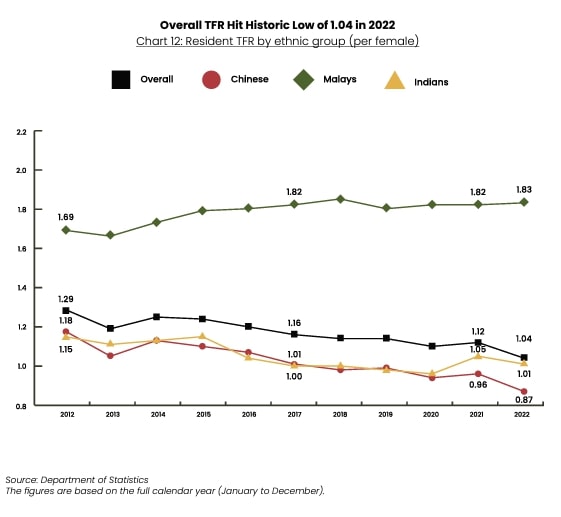
According to the report, the decline in 2022 coincided with the Year of the Tiger in the Chinese lunar calendar.
The Year of the Tiger is seen as inauspicious, as it is believed that children born in that year are temperamental.
The resident TFR for Chinese decreased from 0.96 in 2021 to 0.87 in 2022.
For Indians, there was a slight drop in the resident TFR from 1.05 in 2021 to 1.01 in 2022.
Meanwhile, the resident TFR for Malays increased from 1.82 to 1.83.
Total Population Around 5.9 Million
The report said that Singapore’s total population stood at 5.92 million as of June 2023.
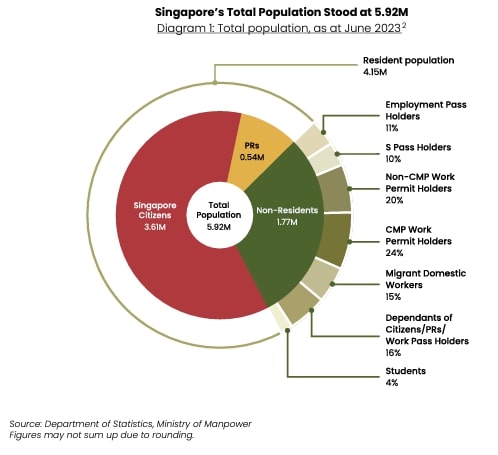
This is a 5% increase from June 2022.
The average total population growth rate over the past five years can be compared to the preceding five-year period, considering the decrease in total population in 2020 and 2021 due to the pandemic.
Singapore has seen an increase in citizens, with the citizen population growing by 1.6% to 3.61 million in June 2023.
In comparison, the citizen population stood at 3.55 million in June 2022.
The number of PRs also grew by 3.7% in the same period, increasing from 0.52 million to 0.54 million.
The non-resident population jumped by 13.1% from 1.56 million in June 2022 to 1.77 million in June 2023.
This jump is mainly because of foreign employment growth across all pass types.
The most significant increase came from work permit holders in the construction, marine shipyard and process sectors.
Moreover, contractors hired more workers to speed up projects delayed by the pandemic.
The report noted that the pace of immigration continues to be stable.
In 2022, 23,082 people were granted citizenship.
Meanwhile, 34,492 people were granted permanent residency.
Rapidly Increasing Ageing Population
According to the report, the number of citizens aged 65 and above is rising faster than in the last decade.
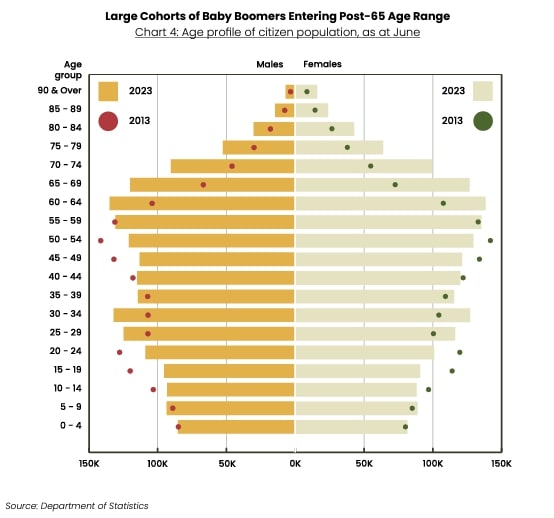
Large cohorts of “baby boomers” have begun entering the post-65 age range.
Currently, about 61% of citizens are aged 20-64 years.
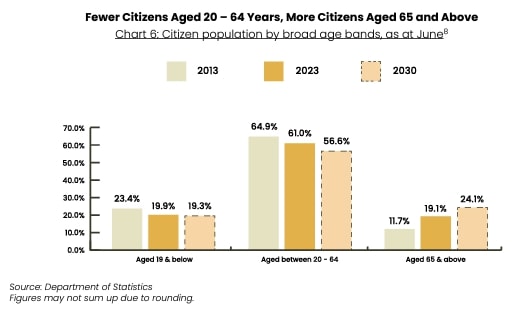
This is a decrease from 64.9% in 2013.
On the other hand, the proportion of citizens aged 65 and above has increased from 11.7% in 2013 to 19.1% in 2023.
By 2030, around 1 in 4 citizens will be aged 65 and above.
If those numbers haven’t convinced you about Singapore’s rapidly increasing ageing population, here’s another statistic.
The report said that the % of citizens aged 80 and above has also increased by 70%.
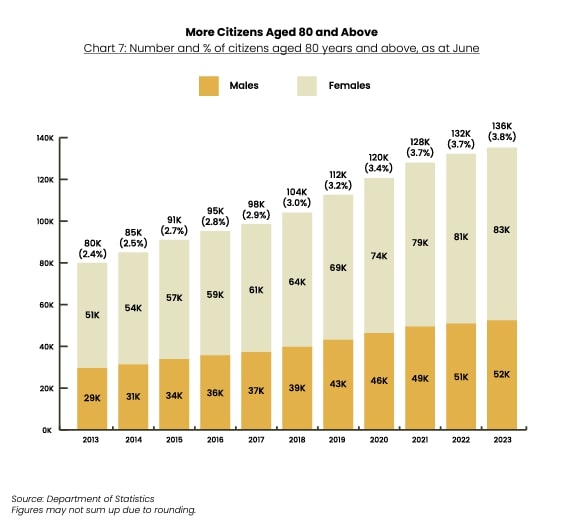
While 2013 saw around 80,000 citizens in this age demographic, there are currently 136,000 citizens in this group.
Adapting to an Ageing Population
Singapore isn’t the only country seeing a rapidly increasing ageing population.
During the book launch for “Singapore Ageing: Issues and Challenges Ahead” in 2023, Prime Minister Lee Hsien Loong noted that China is also facing this problem.
In 2020, over 260 million Chinese were over 60 years old.
The number of seniors in China is expected to increase to 400 million by 2040.
Singapore raised the retirement age to 63 in 2022 to support the rapidly increasing ageing population in Singapore.
The re-employment age was also raised to 68.
The retirement and re-employment age are expected to increase to 65 and 70 by 2030.
Noting that many older Singaporeans prefer to keep active and continue working, PM Lee said, “This will assure people that they can continue working in their golden years so long they are able and keen to do so.”
The Government has also strengthened the country’s healthcare system to accommodate the ageing population.
For instance, the Healthier SG initiative encourages preventive care to reduce the disease burden for Singaporeans.
The country also plans to continue investing in new healthcare infrastructure and upgrading existing ones.
A rapidly increasing ageing population means that there are now fewer people in the working population, leading to a supply shortage of qualified workers.
This sounds like bad news in a country like Singapore, whose only “natural” resource is human capital.
However, a rapidly increasing ageing population isn’t all bad.
Speaking to The Straits Times, Singapore Management University professor Paulin Straughan noted that preparing for an ageing society should encourage Singapore to rethink ways to take advantage of extended longevity.
Furthermore, the decline in the TFR and the rise of child-free dual-income couples and singles have contributed to changing family dynamics.
These changing dynamics can potentially affect caregiving.
Thus, Prof Straughan stressed that more attention needs to be given to the aspirations and needs of the growing number of singles.
Would you be jailed for being half-naked in public? Well, the answer will shock you. Seriously. Watch this to the end and you'll understand:




